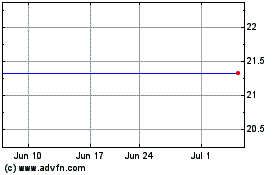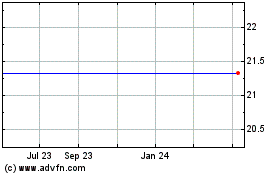During Obama visit, firm plans to play up its part in
modernizing American industry
By Christopher Alessi
MUNICH -- Siemens AG Chief Executive Joe Kaeser aims to show
President Barack Obama that Europe's largest industrial company is
as integral to the U.S. manufacturing renaissance as American rival
General Electric Co.
The president arrived in Germany on Sunday to visit the world's
largest industrial trade fair, the Hannover Messe, where the focus
is on boosting manufacturers' productivity and efficiency through
the Internet.
Siemens is a leader in the so-called Industrial Internet, a
global effort to marry heavy industry with the Internet of Things
-- a concept in which cloud-connected devices all communicate. Mr.
Kaeser has been planning to demonstrate this to Mr. Obama, who was
slated to stop by the German engineering giant's sprawling display
in Hannover with German Chancellor Angela Merkel on Monday.
Mr. Kaeser's goal, he said in an interview, is for Mr. Obama to
walk away saying something like, "Wow, this is really
digitalization at work."
Among the things Siemens will showcase are the U.S.
sporting-goods companies that use the Siemens's product-management
software. One of them is Callaway Golf Co., which will show how it
uses Siemens's software to design and simulate the performance of
new golf clubs that are still on the drawing board.
Siemens's software is "integral to our design process" and "gets
us to the best result more quickly," said Alan Hocknell, senior
vice president of research and development at Callaway.
The U.S. is Siemens's biggest market and a priority for Mr.
Kaeser as he revamps a company that is nearing its 170th
anniversary. He is expanding in developing countries, including
Iran and Egypt, whereSiemens last year signed a $9 billion
power-generation deal.
The U.S., which is home for about 15% of Siemens's roughly
350,000 employees, accounted for nearly 20% of the company's
EUR75.6 billion ($85 billion) in revenue for fiscal year 2015.
Mr. Kaeser believes the U.S., after a period in which financial
services were center stage, has "understood how important it is to
have an industrial base" for its economy. "It's not so much about
bringing production back. It's more about modernizing what they
have."
Mr. Kaeser said Siemens's expertise in automating production
lines and factories gives it an edge over top rival GE. Automation
is considered central to the development of so-called smart
factories, where robotic manufacturing units communicate over the
Web -- with little human input -- to enable product customization
on the shop floor.
A GE spokesman said that while Siemens may have held an
advantage in the field of automation, "these gains are no longer
differentiating." GE leads Siemens on the big data and analytic
technology needed to take the Industrial Internet to the next
level, the spokesman said.
Christopher Niesel, a portfolio manager at Union Investment, a
Siemens shareholder, said the German company has a "lead over GE"
in industrial automation and is pursuing a savvy U.S. strategy by
focusing on it. But he said Siemens faces a challenge competing
with GE in the U.S., where it has deep customer relationships.
Siemens says its offerings -- ranging from power generation to
assembly-line automation to the digitization and analysis of data
-- cover the spectrum needed to master the Industrial Internet.
To tap America's industrial base, Siemens in late 2014 agreed to
buy U.S. oil-equipment maker Dresser-Rand for $7.6 billion. Shortly
after, oil prices started to plummet, and investors have since
questioned both the price and timing of the deal. Mr. Kaeser has
defended the acquisition, which closed last year, arguing petroleum
prices will rebound.
Mr. Kaeser said the Dresser-Rand deal wasn't about getting into
the business of extracting oil and gas, but instead selling to
Dresser's large customer base and expanding Siemens's own product
line.
He said Siemens can help the U.S. oil-and-gas industry weather
low prices through automation and digitization. "The way we help
them survive is we help them to build a digital oil field," he
said.
In January, Siemens agreed to pay $970 million to acquire
U.S.-based simulation software-provider CD-adapco, whose offerings
include tools that enable oil-and-gas industry to simulate the
behavior of reservoirs, digitally manage equipment and analyze
operational procedures.
Union Investment's Mr. Niesel said Siemens is "very well
positioned in the U.S." following the Dresser-Rand purchase, which
should allow the company to expand in the U.S.
A big energy focus for Siemens and its rivals is apart from oil
fields, in power grids that are quickly decentralizing.
"This is about micro grids," Mr. Kaeser said of looming changes.
"There is going to be solar on the rooftop. There is going to be a
few windmills [and] backup conventional power."
To capitalize further on that evolution, Siemens is negotiating
a tie-up for its stagnant wind-turbine business with Spain's Gamesa
Corporacion Tecnologica SA. Gamesa, which is also a wind-turbine
maker, confirmed the talks in a regulatory filing in January, but
Mr. Kaeser declined to discuss the situation.
Since Siemens's supervisory board appointed Mr. Kaeser three
years ago in a contentious management shuffle, he has sought to
streamline Siemens, cut costs and put it back on a path to growth.
Mr. Kaeser sold Siemens's consumer businesses and last year legally
separated its profitable health-care division in preparation for a
possible flotation.
Now investors expect this to be the year that Siemens ends years
of stagnation and resumes growth. Mr. Kaeser said the company can
only achieve that by adapting faster to external changes,
particularly in technology. "You need to understand who survives in
the value chain, who is strong, who is weak and who are going to be
the 'shovel makers' in the 22nd century Gold Rush -- because they
were the ones who became rich, " he said.
Write to Christopher Alessi at christopher.alessi@wsj.com
(END) Dow Jones Newswires
April 25, 2016 02:48 ET (06:48 GMT)
Copyright (c) 2016 Dow Jones & Company, Inc.
Callaway Golf (NYSE:ELY)
Historical Stock Chart
From Mar 2024 to Apr 2024

Callaway Golf (NYSE:ELY)
Historical Stock Chart
From Apr 2023 to Apr 2024
